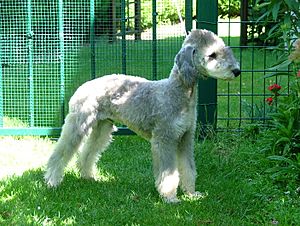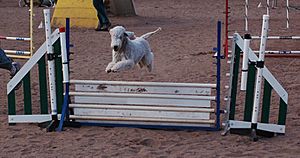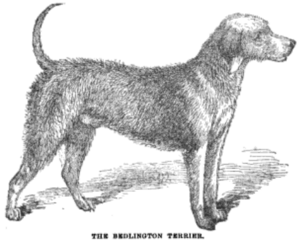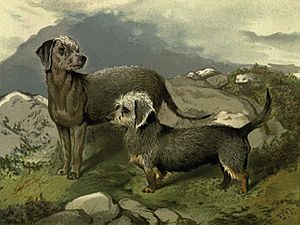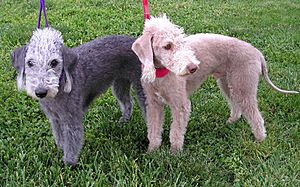Bedlington Terrier facts for kids
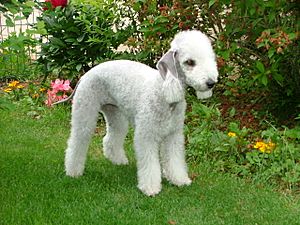 |
|||||||||||||||||||||||||||||||
| Other names | Rothbury Terrier Rodbery Terrier Rothbury's Lamb |
||||||||||||||||||||||||||||||
|---|---|---|---|---|---|---|---|---|---|---|---|---|---|---|---|---|---|---|---|---|---|---|---|---|---|---|---|---|---|---|---|
| Origin | England | ||||||||||||||||||||||||||||||
|
|||||||||||||||||||||||||||||||
|
|||||||||||||||||||||||||||||||
| Domestic dog (Canis lupus familiaris) | |||||||||||||||||||||||||||||||
The Bedlington Terrier is a small dog breed from Bedlington, a mining town in Northumberland, England. These dogs were first bred to hunt small animals.
Over time, Bedlington Terriers have been used in dog racing and many dog sports. They also compete in conformation shows and make great companion dogs. This breed is related to the Dandie Dinmont Terrier, Whippet, and Otterhound.
Bedlington Terriers are known for being very adaptable. They are excellent swimmers, much like water dogs such as the Newfoundland. They are also very fast and have great stamina. They love snow and can run quickly on ice or in deep snow.
These dogs are often compared to lambs because of their appearance. Their fur can be blue, liver (a reddish-brown), or sandy, sometimes with tan markings. They have a special tuft of fur on their head called a topknot. Their coat does not shed much and has little odor. However, it needs weekly grooming to stay healthy.
The breed was first called the Rothbury or Rodbury Terrier. The name Bedlington Terrier was first used in 1825. Some Bedlington Terriers can trace their family history back to 1782. The first dog show with a class for Bedlington Terriers was held in Bedlington in 1870. In early shows, some Bedlington Terriers were dyed to make their fur look better. In 1948, a Bedlington Terrier named Rock Ridge Night Rocket won "best in show" at the famous Westminster Kennel Club Dog Show.
Bedlington Terriers can have a health issue called copper toxicosis. However, other than some eye problems, they are generally a healthy breed.
Contents
What Does a Bedlington Terrier Look Like?
Appearance: A Lamb-like Dog
Many people say the Bedlington Terrier looks like a lamb. Some have also compared it to a smaller version of the Scottish Deerhound. One expert, George Shields, even said that well-bred Bedlingtons have the spirit of a racehorse.
Bedlington Terriers come in blue, liver, or sandy colors. They can also have tan markings with any of these colors. Bedlingtons have a special "greying gene." This gene makes puppies born with black or dark brown fur lighten to grey or liver as they get older. The fur on top of their head forms a unique shape called a topknot.
The dog's coat is often described as shaggy and tough. It has also been called "linty" because of its texture. This gave the breed the nickname "linty-haired terrier." Their coat is a mix of hard and soft hairs. Keeping a "show clip" (groomed for dog shows) is very difficult and expensive. The fur in a show clip cannot stick out more than 1 inch (2.5 centimetres) from their body. It must also have a "crisp" texture.
If their coat is not groomed regularly, it can quickly become messy. Because of this, most Bedlingtons kept as pets have a simpler "pet groom" style. Like Poodles, Bedlington Terriers are considered a nonshedding and hypoallergenic breed. They have very little dog odor if their coat and ears are healthy and groomed often. Bedlingtons usually enjoy being groomed.
Their head should be rounded with no sudden dip (called a stop). Their eyes are small and almond-shaped. Their lips fit closely and do not droop. The dog's back should be arched, and its body should be a bit longer than it is tall.
For male dogs, the preferred height is 16.5 inches (42 cm). An acceptable range is 16 to 17.5 inches (41 to 44 cm). For females, the preferred height is 15.5 inches (39 cm). The acceptable range is 15 to 16.5 inches (38 to 42 cm). Both male and female Bedlingtons should weigh between 17 and 23 pounds (7.7 and 10.4 kg). They move with a light, springy gait.
What is the Bedlington Terrier's Personality Like?
Temperament: Brave and Playful
Bedlingtons are known for being sharp and brave. Their bark sounds like a hound and has been compared to a machine gun. They are fast dogs with great stamina. Bedlington Terriers are just as quick in water as they are on land. Their swimming speed can even match that of a Newfoundland. They can run fast enough to keep up with a horse. Because they have Whippets in their family tree, they sometimes like to chase things.
They are very versatile dogs. Some Bedlingtons can be a calm house dog, a hunting dog, or even help catch vermin like rats or badgers. They are also known for their intelligence and determination when hunting.
Bedlingtons can be quite fond of fighting, especially when other dogs are around. They might get jealous. Some people have said these dogs are strong fighters for their size. In the past, they were sometimes used in dog fights.
However, major dog organizations like the AKC (American Kennel Club) and the ASPCA (American Society for the Prevention of Cruelty to Animals) describe the breed as "mild" and "gentle." They recommend Bedlingtons as good pets for children. PetFinder says the breed is soft-tempered, friendly, loving, loyal, and a quiet house dog. Even though they might chase small animals outside, they usually accept them inside the home.
Bedlingtons are playful and cheerful. They can sometimes be high-strung and stubborn. The New Zealand Kennel Club warns against keeping them with dogs that have very strong personalities. This is because Bedlingtons can become fierce fighters if challenged, despite their gentle look. Otherwise, they usually get along well with other dogs.
Some breeders believe that the Bedlington Terrier's working ability and courage have decreased since they started being bred for dog shows. Some think Poodles might have been mixed into the breed to make their coat easier to groom.
How Did the Bedlington Terrier Originate?
History: From Miners' Companions to Show Dogs
The Bedlington Terrier was first bred in the village of Bedlington, Northumberland. They were known as "the favorite companion of the northern miners." At first, they were called Rodbury Terriers, Rothbury Terriers, or "Rothbury's Lambs." This was because the Lord of Rothbury especially liked these dogs. Before that, they were known as "gypsy dogs." This is because Romani people (called 'Gypsies' back then) and poachers used them to hunt.
The first mention of the Bedlington Terrier (then called Rothbury or Rodbury Terrier) was in 1825. This was likely in a book called The Life of James Allen. However, some dogs' family trees can be traced back to 1782. James Allen's father, William, was a skilled otter hunter. He kept Bedlington Terriers to help him hunt. Owners also valued them for rabbit coursing and racing. This was until the Whippet became more popular for racing.
The name Bedlington Terrier was first given to a dog named Young Piper. He was owned by Joseph Ainsley. Piper was known as "the best of his race" and had a reputation for being very brave. Piper started hunting badgers at eight months old. He continued hunting other animals considered vermin until he became blind. Piper is also famous for saving a child from a pig, holding the animal off until help arrived. Piper lived to be fifteen years old.
The first dog shows that had a class for the Bedlington Terrier were held in Bedlington in 1870. The next year, a Bedlington Terrier class was held at a show at Crystal Palace. A red dog named Miner won first prize there. Miner also won a show in Birmingham. The Bedlington Terrier Club was started in 1875.
Many dogs in early shows were clipped and dyed. This was done to make them look more like the breed standard and improve their chances of winning. It is not known if the judges knew about this practice or if they cared. Eventually, the practice of trimming was accepted by The Kennel Club. They allowed it if the trimming was done to "smarten a dog to show his shape and general contour."
Bedlington Terriers are closely related to the Dandie Dinmont Terrier. In fact, the Earl of Antrim once showed two terriers from the same litter. One won shows as a Dandie Dinmont, while the other won as a Bedlington. Bedlington Terriers are also related to the Kerry Blue Terrier and the Soft-coated Wheaten Terrier. The shape of their back suggests they might be related to the Whippet. They may also be related to the otterhound. Bedlington Terriers have been crossed with Whippets to create a Lurcher with "extra guts, pep, [and] fire."
In 1948, Ch. Rock Ridge Night Rocket won "best in show" at the Westminster Kennel Club Dog Show. He was then featured in LIFE magazine. One of his descendants, Ch. Femars' Cable Car, was on the cover of Sports Illustrated in 1960.
Bedlington Terrier Health Information
Longevity: How Long Do They Live?
Bedlington Terriers usually live for about 13.5 years. This is longer than most purebred dogs and longer than most breeds of similar size. The oldest Bedlington Terrier in a 2004 UK survey lived to be 18.4 years old.
The main reasons Bedlington Terriers died in the UK were old age (23%), kidney/bladder problems (15%), and liver problems (12.5%). The main liver problem was copper toxicosis. Dogs that died from liver diseases usually died younger than dogs with other causes of death.
Bedlington Terrier owners in the UK reported common health issues in living dogs. These included reproductive problems, heart murmurs, and eye problems. Eye problems can include epiphora (excessive tearing), retinal dysplasia, and cataracts. Bedlingtons seem to get these eye diseases more often than other breeds. They also have a higher chance of kidney problems. About 5% of living dogs had copper toxicosis.
Breeding dogs that are too closely related can be a concern. Responsible breeders will test all puppies' DNA. They will not allow dogs that carry the copper toxicosis gene to be bred. This practice has greatly reduced how often this disease occurs in the breed. Other than these issues, Bedlingtons are generally a very healthy breed.
Copper Toxicosis: A Special Concern
Copper toxicosis is a genetic disease. It means that copper builds up in the liver. This disease is similar to Wilson's disease in humans. Bedlington Terriers are more likely to get copper toxicosis than most other dog breeds. Other breeds like West Highland White Terriers, Skye Terriers, and Doberman Pinschers can also get this disease.
Bedlington Terriers are the only dog breed where red blood cell breakdown (haemolysis) has been reported due to this condition. Studies show that in Bedlingtons, the disease is caused by a faulty protein. This protein makes cells store too much copper.
There are three types of this disease:
- The asymptomatic form means copper builds up, but the dog shows no signs of illness.
- The fulminating form is seen mostly in young dogs. It causes death quickly, often in two to three days. Stress is thought to trigger it.
- The chronic form means liver disease slowly causes the dog's death over a long time.
Bedlingtons also tend to build up iron in their liver. However, this is not as much as the copper buildup.
See also
 In Spanish: Bedlington terrier para niños
In Spanish: Bedlington terrier para niños



